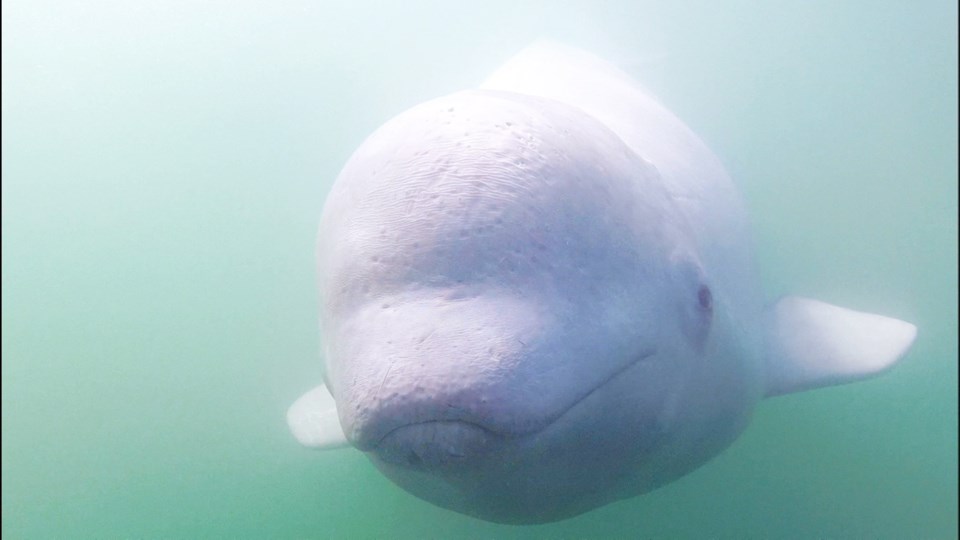What: Call of the Baby Beluga
Where: CBC TV
When: Tonight, 8 p.m.
After spending years developing two award-winning films about Luna the killer whale, you’d think Suzanne Chisholm and Michael Parfit would have had their fill of whale movies.
Not a chance, say the Sidney-based couple best known for Saving Luna, a 2007 documentary that chronicled the baby orca’s short life and impact.
Four years after the release of The Whale, their Hollywood version narrated by Ryan Reynolds, the husband-and-wife filmmakers have completed another whale movie.
Call of the Baby Beluga, which debuts tonight at 8 on CBC’s The Nature of Things, took them far from B.C.’s coastal waters where Luna’s dramatic life unfolded.
The one-hour documentary hosted by David Suzuki focuses on a stranded baby beluga and the scientists and conservationists who hope that wild female belugas in Quebec’s St. Lawrence River will adopt it.
The story is the hook for an exploration of the lives of an estimated 900 endangered beluga whales that naturally adapted to Arctic survival, but have survived in more temperate, increasingly polluted waters once populated by 10,000 belugas.
“You can’t get tired of something you don’t fully understand yet,” says Chisholm, explaining why the couple gravitated toward familiar material.
“For all that science has told us, all the cultural shifts, there’s so much about [whales] we still don’t know. It’s not that long ago that people had disdain for them because they got in their way. How can you not be inspired by them? The way we treat these animals is constantly evolving, and there are good news stories now. It’s progress, and to us that is interesting.”
Parfit says it doesn’t surprise them when people say they had no idea that whales, most often regarded as major ocean dwellers, live in the St. Lawrence River.
“There are even people who live in that part of the world who don’t know,” Parfit says. “I had no idea it was such a spectacular place full of whales — almost a Brigadoon kind of place.”
This ecosystem, Chisholm adds, is the only place on the planet you can find both belugas and blue whales. They’re two of 13 species of cetaceans that have been found there.
“In my lifetime, people were shooting these whales for sport, but people now look upon them as an asset,” the Quebec-born flimmaker said.
After doing preliminary work in the summer of 2014, the couple and their young son, Christopher, then a toddler, loaded their cameras and camping gear into their single-engine Cessna 182 and flew to Tadoussac, Que., where they met Robert Michaud, a scientist who has studied belugas since 1983.
Other featured experts include Veronique Lesage, a leading beluga scientist with Fisheries and Oceans Canada; Valeria Vergara, a research scientist from the Vancouver Aquarium; Leone Pippard, a former journalist who first sounded alarms in the 1970s about threats to the beluga population; and Catherine Kinsman, the founder of Nova Scotia’s Whale Stewardship Project, who is concerned about a solitary beluga becoming too sociable for its own welfare.
Parfit says while these whales “are not as glamorous as the orcas, once you get to know them they’re very appealing,” a sentiment he extends to their human helpers.
“To me, there’s a kind of heroism there,” Parfit says. “They’re working so hard and they have other things to do.”
Creating a 42-minute documentary for CBC’s flagship nature program with Suzuki’s distinctive narration posed a different kind of challenge, one Parfit compares to writing a sonnet, in terms of constraints.
“Film is a more emotional medium, and we didn’t want to shy away from that,” he adds, explaining why they also focus on the human compassion that complements scientific knowledge.
Human empathy — a topic they’d like to explore in a future project — plays a key role in the film that illustrates how it helps these whales whose complex customs and social lives are studied.
Shooting began last January and continued after the couple drove last June to central Quebec, where they rented a house through October in Sacre-Coeur, Que.
Their travels took them to Liverpool, N.S., to film Kinsman’s sequences about her work with solitary belugas. After returning to Quebec, they were joined by Michael’s son David Parfit, a composer and filmmaker.
Father and son became drone pilot and catcher, respectively, for aerial sequences filmed using unmanned aerial vehicles, which turned out to be a learning experience.
Although Michael is an accomplished pilot, he said piloting a drone day after day on boats loaded with masts and antennae posed unique challenges, including a need for intense focus and co-ordination. “What was so striking was that you can often see animal behaviour better from the drone than from underwater,” he says.
Chisholm notes that the drone removes the distraction of a camera-toting diver, which can change the whales’ behaviour.
The whales aren’t paying attention to the drone, “so they’re doing their own thing,”says Parfit, whose subjects tended to stay close to the surface.
“Once you get the hang of it, you can follow them for many minutes.”

-thumb.png;w=120;h=80;mode=crop)

